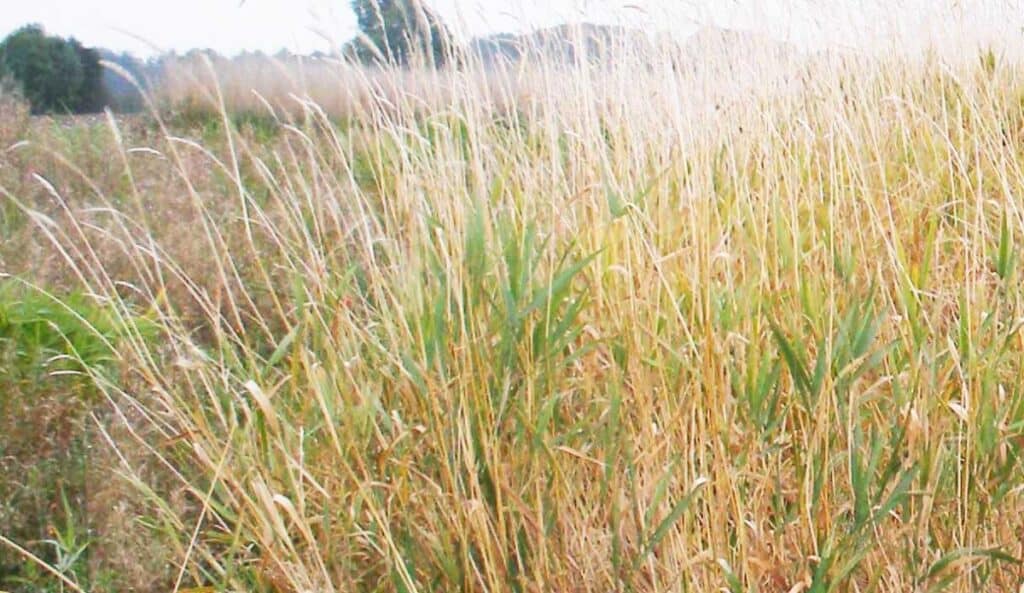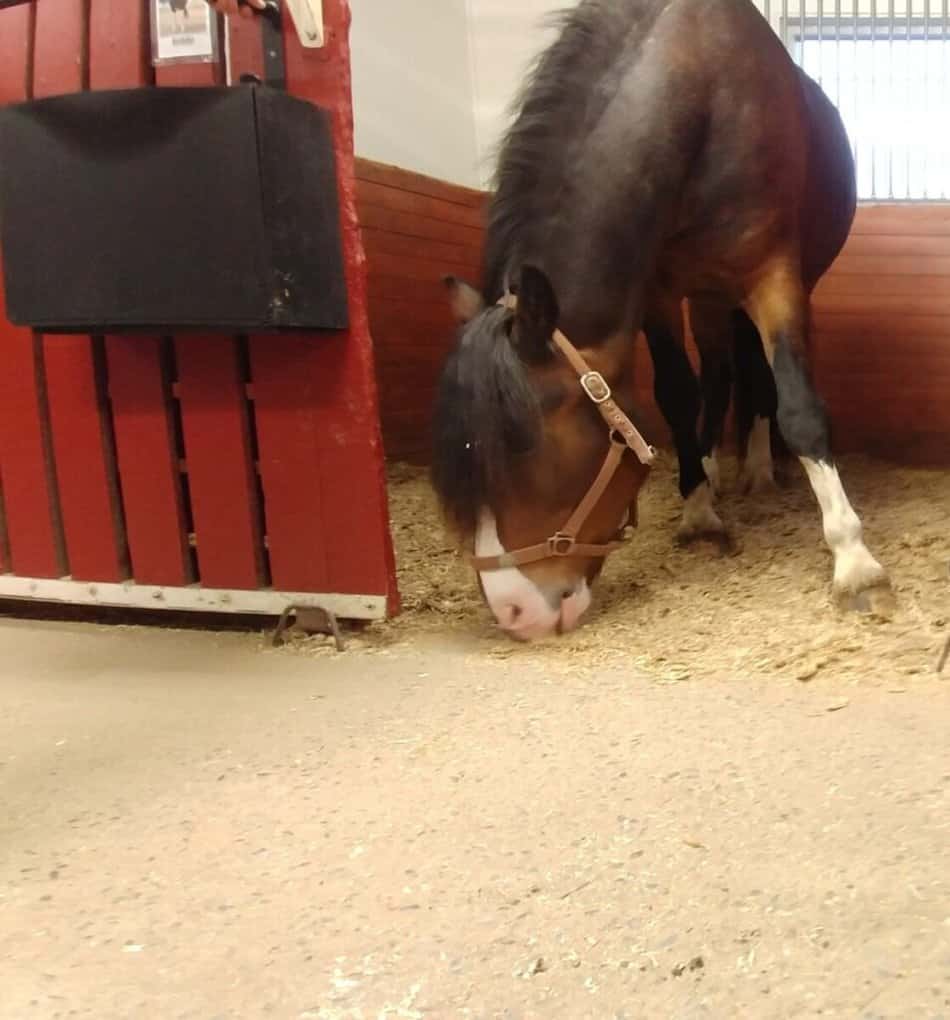In Sweden trials are now underway with a new bedding material that could make horse manure more attractive. It is made from the plant reed canary grass, which has high sustainability scores.
Reed Canary Grass

Reed canary grass is a grass that grows along banks, ditches and damp meadows throughout Sweden. In the EU-funded GO-GRASS research project in Sweden, work is now ongoing to launch reed canary grass as bedding in horse stables and other areas.
Bo Lundmark runs the company Glommers Miljöenergi in Västerbotten in the north of Sweden, and has been harvesting reed canary grass for almost 30 years, with a variety of uses in mind. Now he is one of the people in the EU project launching reed canary grass as an alternative to cutter shavings and straw in stables.
“Reed is simple and long-lived, and above all it hasclimate benefits. It grows for 10-15 years before you have to sow new seed, and it is easy to work with”,
Bo Lundmark.
The grass grows on land that would otherwise often be fallow. It is harvested with a mowing machine, strung up and baled into round bales. Because it is dry when harvested in early spring, no energy-intensive drying process is required, and the reed can be directly processed and briquetted. The briquettes are heated to get rid of all potential bacteria in the grass, and then raked into bedding material.
It is then ready to be used in the boxes.
Reed Canary Grass in Use.
During the winter and spring, reed straw has been tested as bedding on several horse farms in Västerbotten.

Heidi Hiltunen Reviews The Bedding
“We’ve tried it in a stable with six boxes”, says Heidi Hiltunen from ZiOne Stables outside Umeå. Their business is focused on educating trotting horses and competing with them. The business also includes taking care of horses for rehabilitation.
“The stalls are used for competing trotting horses, and the bedding worked well, so we were very happy. It might be a bit more expensive compared to other shavings, but it’s quicker to clean it from manure, so it saves time, and then there’s a profit in the end”, she continues.
Cameras in the stables showed that the boxes with reed canary grass had a positive effect; the time the horses lay down and rested, increased.
“That’s good,” says Heidi Hiltunen. “We want the competing horses to rest, and it shows that they think it was a good bed.”
The horse lover makes a comparison with wood shavings, which are around the same price and as easy to maintain.
“But the horses don’t lie on it so willingly. If you compare different aspects, such as the time it takes to keep it clean, the price, the comfort and the fact that it is easy to get rid of manure with reed canary grass, the canary grass wins out.”
Jens Eriksson is a trotting trainer in Skellefteå and has tried the bedding on three horses.
“When you put it out, it creates a bit dust, but then it settles well, and I had a really good feeling about it.Two of my horses liked it, and the third liked it a lot, so he ate it, much like some horses eat straw. If your horse eats too much of the bedding, it’s not as cost-effective.”
Jens Eriksson would be happy to use reed canary grass on a larger scale if he could be sure that the supply was good and that he could get it transported to the farm.
Working on Distribution of Reed Canary Grass
“We are working on finding solutions for distribution, but the recent sharp rise in freight costs has not been helpful”, says Cecilia Wahlberg Roslund, coordinator of the Swedish part of the EU Go-Grass project.
“Another important key is the volume. We need customers to be willing to buy a certain volume at once to justify the freight”, she continues.
Eleonor Hedman From Norsjö Riding Club
“Good bedding for horses should have good absorption capacity, not be too dusty, and then you should be able to sell the manure. The bedding should be easy to handle and not too expensive”, comments Eleonore Hedman from Norsjö Riding Club.
The club also has a riding school, and they have been using reed straw for various periods in recent years.
“Here in our region, it is becoming increasingly difficult to get hold of cutter shavings, and straw is not that easy to come by either. Straw is also more difficult to clean. The fact that reed is locally produced is a crucial factor”, says Eleonore Hedman. “It can also be grown on land that might not otherwise be used, and by growing and harvesting the reed we can keep the landscape open.”
Yvonne Petterson – Owner of Boarding Stable
Yvonne Petterson, who runs a boarding stable in Umeå, has a horse thatalso enjoyed eating the reed canary grass. However, neither she nor Jens Eriksson, the trotting trainer, could see that the horses reacted negatively to eating reed, and there is no research to suggest that horses are harmed by eating reed.
“I noticed that the reed bed was more stationary, and the material lasted longer than shavings. It also had good absorbency, so it does well in permanent beds. It smells good, a bit sweet actually, so overall we were pleased”,
Yvonne Pettersson.
Check Out The Video about the Production of Reed Canary Grass.
Price of The Bedding
The price has not yet been set for reed canary grass. During the project, the straw is sold for SEK 72 (~7€) per bale, and the goal is a price that can compete with the price of wood shavings, based on the aspects that the straw lasts longer and can be cleaned more quickly.
“Sustainability aspects are the strongest arguments for reed canary grass”, says grower Bo Lundmark.
“Manure mixed with shavings requires a lot of nitrogen to decompose, so the circularity is much better with reed. By growing reed canary grass we also increase carbon storage in the soil and reduce carbon emissions. In addition, it is grown locally, making the transportation shorter, and horse manure mixed with reed canary grass is more attractive than horse manure mixed with wood shavings.”
Bo Lundmark
Facts about Go-GRASS
The GO-GRASS project will develop a set of small-scale bio-based solutions to unlock the overlooked potential of grassland across Europe and create new business opportunities for rural areas.
The project has demos in Sweden, Germany, Netherlands and Denmark, with different focuses.
Facts about Reed Canary Grass.
Reed canary grass is a perennial grass (Phalaris arundinaceae) occurring commonly in marshy meadows and ditches of Europe and North America, used in some areas for forage, and having broad leaves and narrow dense panicles.
This Piece was written by Anna Nyberg.
